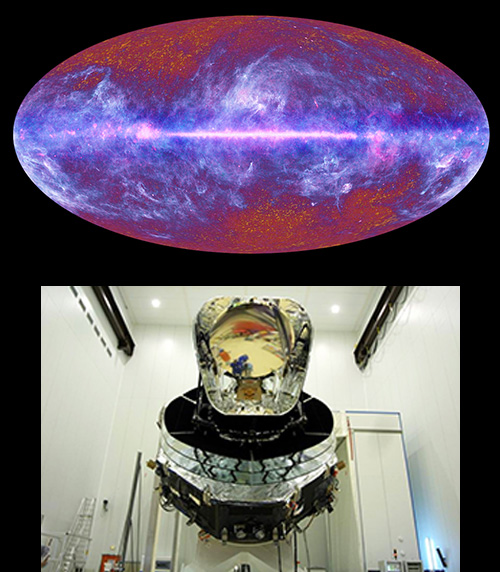Planck << plahngk >> was a spacecraft launched on May 14, 2009, to measure the cosmic microwave background (CMB) radiation. The CMB radiation consists of microwaves seen in every direction in space. Scientists believe that it is energy left over from the early universe, immediately after the big bang. The big bang is the event that began the expansion of the universe.

Planck produced detailed maps of variations in the CMB radiation, improving on measurements made by earlier spacecraft. By studying these maps, scientists can “see” the conditions in the early universe. The craft was named in honor of the German physicist Max Planck . It was launched by the European Space Agency (ESA) on the same rocket as another spacecraft, the Herschel Space Observatory. Planck orbits the sun near the second Lagrange point associated with the sun-Earth system (L2), a point about 900,000 miles (1.5 million kilometers) from Earth (see Lagrange point ).
Observations of the CMB give scientists a direct view of the universe more than 13 billion years ago, about 380,000 years after the big bang. Scientists believe that faint variations in the temperature of the radiation, called anisotropy, came into being within minutes of the big bang. However, strong interactions with matter obscured these early variations, making it impossible to see back farther than 380,000 years after the big bang. These temperature variations correspond to variations in density in the early universe. Scientists believe that the areas of high density later formed stars and galaxies.
Two instruments on Planck measured anisotropy in the CMB radiation: the Low-Frequency Instrument (LFI) and the High-Frequency Instrument (HFI). Together, they took measurements at nine different microwave frequencies. Planck observes the sky in multiple frequency bands to help filter out microwaves that are not part of the CMB radiation. These microwaves come largely from our own galaxy, the Milky Way, but may also come from other galaxies. The HFI ceased to function in early 2012 after it ran out of liquid helium coolant. Several European countries, Canada, and the United States contributed to the development of Planck.
In March 2013, scientists announced results from the Planck mission. The Planck data placed the age of the universe at 13.82 billion years, several hundred million years older than previously thought. The craft also observed the universe to be expanding at a sightly slower rate than in previous findings. Planck data also showed the universe to be slightly lopsided, with more matter concentrated in one direction.
Planck was officially deactivated in October 2013. The spacecraft was maneuvered into an orbital path that would not interfere with future missions and all instruments were deactivated.
